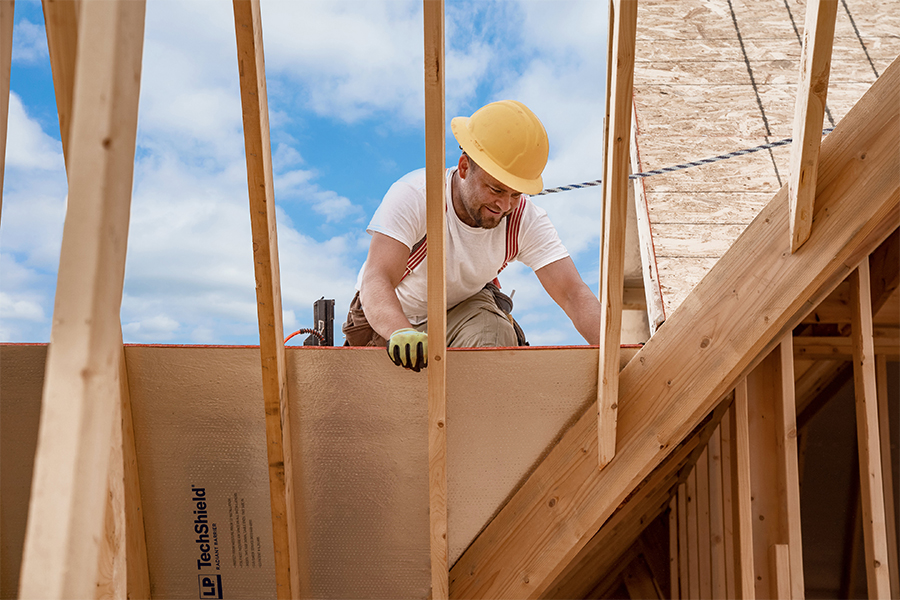Business Advice4 min
Energy-Efficient Building Materials For Hot Climates
In hot climates, energy efficiency can be a top concern for homeowners. Increased needs for cooling alone can lead to higher energy costs, so builders and homeowners alike are typically on the lookout for ways to mitigate energy spend and create energy-efficient house designs for hot climates.
One way for builders to address the need for efficiency is to install energy-efficient radiant barriers. Let’s dig in and see how LP’s #1-rated radiant barrier product, LP® TechShield® Radiant Barrier, works and how it can fit into your build.
Why Do Energy-Efficient Buildings in Hot and Dry Climates Need Radiant Barriers?
Many cities in the United States experience temperatures that top 90° F for more than 67 days in an average year, which can add up to significant energy expenses. For that reason, homeowners living in hot climates may be more concerned about keeping energy costs under control.
In fact, according to a study conducted by the National Association of Home Builders (NAHB) titled “What Home Buyers Really Want,” data showed that 9 out of 10 buyers would choose a home with energy-efficient features over a home with lower upfront costs. This shows the need for builders to practice energy-efficient construction in hot, humid climates.
Craig Miles, Director, OSB Sales & Marketing, considers defending a home against rising energy costs an issue of resiliency. "At LP, we define resiliency in a broader context," Miles says. "To me, resiliency means not only that your home won't get knocked down, but how resilient is your home to unpredictable factors?"
That’s where radiant barriers come in. Though we can’t predict the costs of energy, we can help to ensure homes have the ability to mitigate energy use as much as possible.
How Does an Energy-Efficient Radiant Barrier Work?
For energy-efficient buildings in hot and dry climates, a radiant barrier is crucial. As the sun heats up roof panels, a panel with a radiant barrier reduces the amount of heat that emits from the roof into the home’s attic. As a result temperatures in the attic are reduced, which helps keep cooling costs down.
LP TechShield panels feature a radiant barrier overlay on engineered wood, combining the strength of engineered OSB products with heat-reducing technology. When in place and installed correctly, these panels can help block up to 97% of radiant heat in the roof from emitting into the home's attic, reducing attic temperatures by up to 30° F.
Additionally, LP's patented VaporVents™ technology, created with LP's post-lamination foil incising process, allows any trapped moisture to escape from the panels during and after installation. This detail is especially important in energy-efficient construction for hot, humid climates.
How Does LP TechShield Radiant Barrier Work With My Build?
Though they work hard as an energy-efficient radiant barrier, LP TechShield radiant barrier installation is done just like conventional roof sheathing. The panels are available on APA Exposure 1 rated OSB in common performance categories, making them easy to plan for within your build. Their common size, 48 inches by 96 inches, also gives you a standard measurement to plan for when ordering.
Using LP TechShield panels in your build may also help you qualify for various energy codes and certifications, such as Green Building Credits, energy rebates and lower HERS scores. The HERS index, in particular, is the industry standard to measure a home’s collective energy efficiency. LP TechShield panels may help lower your build’s score, and the lower the score goes the more efficiently the home operates.

Building Materials for Hot Climates Backed by LP
As a builder, "you must consider what you need to be resilient against," says Miles. When you build with LP, there's an answer for most resiliency threats, including building materials for hot climates. "Ultimately, you need to be resilient against factors outside of your control," Miles adds, one of which is energy costs.
In addition to the product helping to lower energy costs, LP TechShield panels are backed by a 20-year transferable limited warranty, offering peace of mind and assurance of LP’s confidence in their innovative approach to energy management.
Creating an energy-efficient house design for a hot climate? Learn more about LP TechShield roof panels here and check out the LP Structural Solutions portfolio of products for additional innovative ways to Defend Your Build®.
Continue Reading
Resiliency Solutions
5 minIntroducing LP® SmartSide® ExpertFinish® Naturals Collection™: Nature-Inspired Beauty Meets Engineered Performance
We’re excited to introduce the LP® SmartSide® ExpertFinish® Naturals Collection™, a bold new addition to our trusted line of engineered wood siding and trim that delivers the warmth and beauty of nature with the advanced protection and performance builders and homeowners expect.
Labor Solutions
5 minChoosing the Right LP® Structural Solutions Product for Your Build
When it comes to building strong, reliable, and high-performing structures, the materials you choose matter. At LP Building Solutions, we understand that every project, whether it's a single-family home or a multifamily development, requires structural components that meet your needs for strength, durability, and efficiency.
Sustainability Solutions
5 minBuilding a More Sustainable Future with LP Building Solutions
In today's world, sustainability is no longer just a buzzword, it's a blueprint for responsible living and smarter building. As the construction industry seeks ways to reduce its environmental footprint, LP Building Solutions is focused on providing innovative building materials for eco-conscious builders to help reshape what it means to build sustainably
News & Stories3 min
History of Partnership with Gary Sinise Foundation
The LP Foundation is a proud partner of the Gary Sinise Foundation, which supports wounded veterans in several ways. You can learn more about the LP Foundation here.